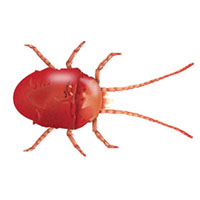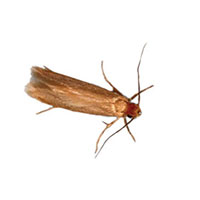Clover Mite Diet
Clover mites are not blood-feeders but feed on plants getting their nutrition by sucking sap and plant juices from various plants, including grasses, clover, trees, shrubs, and other common lawn plants. High numbers of clover mites are often associated with maintained and well-fertilized lawns.
Clover Mite Habitat
Clover mites build up very large populations around structures surrounded by lush, well-fertilized lawns and thick shrubbery. Populations of the insects are at their peak in the spring and early fall when plants are thriving. They often move into buildings in tremendous numbers in the autumn when vegetation begins to die. Clover mites can become a nuisance in multi-story buildings if living on rooftops and patios where mold or mildew provide sources of food.
They get into houses through cracks around windows and doors, especially on the south and west side of buildings. Because of their small size, even the tiniest of gaps may provide entry. The pests can also climb home siding to come inside through openings into attics and upper levels. The mites tend to invade homes and indoor facilities if host plants are dried up or cut off. Once inside, they move upward as the sun warms the surface above them or move to a warm surface until they find a protected area. If the new surface becomes too hot or cold, the mites roam in search of a new, more favorable location.
Clover Mite Life Cycle
Clover mites reproduce by parthenogenesis, which means females can reproduce without being fertilized by males. Their population is composed entirely of females. They lay approximately 70 tiny, reddish eggs in late fall, which will overwinter in a dry, protected location such as sidewalk cracks, walls of buildings, and logs. Eggs hatch the following spring when temperatures are between 40-70 degrees.
Overwintering mites hatch in the spring and begin to produce second generations. Spring generations will aestivate, which is a form of summer hibernation where mites go inactive on warm, dry days. Second generations typically complete in the fall. A generation lasts approximately one month. Adult clover mites live for about two weeks outdoors, as long as weather conditions are suitable for their development.
Clover Mite Damage
Although clover mites are not a danger to human health and do not destroy furniture, clothing, or food items, they can become an indoor nuisance when invading homes, businesses, and medical facilities. Clover mites do not create long-term infestation problems because once inside, they quickly die. Though clover mites are harmless and do not feed on blood like other species of mites, they are a great annoyance to building occupants. If crushed, they leave a red stain on walls, floors, or furnishings. This stain is not the mite’s blood but is the mite’s body pigments.
Clover Mite Prevention & Control
Clover Mite Prevention
To reduce the risks of a clover mite infestation, follow the steps below:
- Eliminating lush vegetation to an 18-24″ band around the perimeter of structures.
- Seal cracks on the foundation, window frames, and siding to prevent clover mites from laying eggs or entering the home.
Clover Mite Control
Control of clover mites is best left to your pest management professional. They will perform an inspection and use the inspection findings to prepare an integrated pest management plan for clover mite control. This plan will include some helpful preventive measures the homeowner may choose to employ, as well. Among these preventive measures are:
- Using a wet sponge or a crevice attachment of a vacuum cleaner to remove mites, making sure to take precautions to avoid crushing the mites and causing stains.
- Removing all grass and weeds from around the foundation perimeter and leaving a vegetation-free strip about two feet wide, especially on the south and southwest sides of the structure.
- Sealing holes, cracks, and gaps on the foundations, windows, and doors, discouraging mites from entering the structure.
- Making sure to use window screens that are tight-fitting.
- Making sure not to over-fertilize the lawn or ornamental plant areas since clover mite populations tend to do better in lawns that are well fertilized.
At Batzner Pest Control, we offer our pestfree365 program for homes infested with clover mites as well as over 25 other pests. To learn more about our home pest control services or to find out how we can help you combat clover mites in your commercial establishment, please contact us today.
Need help with Clover Mites?
We'll call you! Leave your information below.



